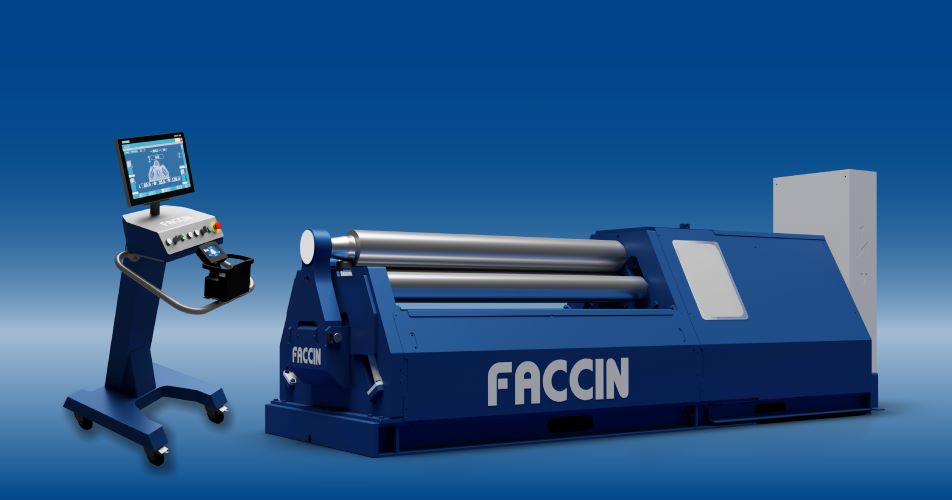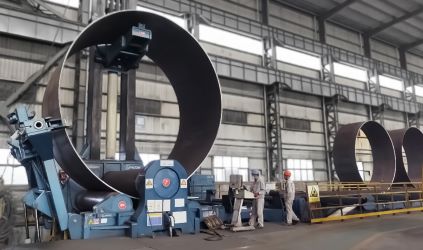Faccin Group, specialising in crafting cutting-edge plate rolls, angle rolls, head forming lines, and special machines for diverse industrial applications, unveiled three innovative products simultaneously at EuroBLECH2024.
Driving Renewable Energy: The Technology Fueling Offshore Wind Farm Component Production
With Faccin® Wind Tower Automation System, the offshore industry sets sail towards unmatched efficiency and excellence. Learn how this innovative system transforms steel plates into robust structures ready to harness the power of the wind.
Enhance Fabrication Potential With FACCIN Group’s Cutting-Edge Tube Bending Solutions
FACCIN machines offer a multitude of benefits, including heightened productivity, unparalleled precision, consistent repeatability, and user-friendly operation for all skill levels. Its advanced portfolio ensures clients maximise all the equipment advantages.
Pressure Vessels And High-Tech Rolling Solutions For Oil & Gas Industry
Learn how to ensure safety and reliability with FACCIN’s solutions in fabricating high-quality pressure vessels for the oil and gas industry.
Faccin’s Insights On Choosing The Right Rolling Technology
Faccin details the keys to collaborating with the right partner — for the machine quality, efficiency it offers, as well as the long tool life for plate rolling.
Faccin For The Shipbuilding Companies: Tailor Made Machines And Automation
Antonella Galuppini, Senior Technical Sales Manager of Faccin explains how the organisation embraces Industry 4.0.
Faccin Ensures A Successful Rolling System For CS Wind Malaysia
CS Wind Malaysia looked to Faccin to address their needs and deliver innovative quality and easy to use solutions.
FACCIN Group In 2022
Responses attributed to Javier Lanfranchi, Senior Sales Manager & Head of Strategic Marketing.
A Reliable Partner for Your Wind Energy Project
Faccin Group’s Eng. Andrea Comparin, Rafael Soto, and Eng. Diego Morbini talk about the company’s Wind Towers Division, how they are helping address the challenges in wind tower manufacturing, and the future for the industry.
Faccin S.p.A. is a leading metal forming machine producer that manufactures the widest range of plate rolls, angle rolls, dished head, and special machines. In this feature, Eng. Andrea Comparin, Rafael Soto, and Eng. Diego Morbini, all senior technical sales managers at Faccin Group Wind Towers Division, talk about the company’s Wind Towers Division, how the company is helping address the challenges in wind tower manufacturing, and the future for the wind tower industry.

(From L-R) Eng. Andrea Comparin, Rafael Soto, and Eng. Diego Morbini of Faccin Group Wind Towers Division.
WHY DID FACCIN GROUP CREATE A WIND TOWERS DIVISION?
Eng. Andrea Comparin (AC): Achieving the Paris Climate Agreement goals by 2050 will require a substantial acceleration across sectors and technologies, particularly in onshore and offshore wind power generation. This sector will play a significant role by becoming a prominent energy generation source, achieving an estimated 33 percent of the total production.
This acceleration is only possible by increasing the wind capacity installation in the next 30 years, which means that the wind power industry will have to be prepared for such a significant growth. This rise of economies of scale will impact the supply chains, which have to be more competitive and technologically advanced.
The production of wind towers does not escape this reality. Should the towers continue being a tube made of several round cans of ever thicker steel plates, the taller the towers are, then, a fast and precise rolling of these cans is crucial for manufacturers to stay competitive in the years to come.
Faccin Group’s Wind Towers Division has been created with the aim to, first, deeply understand the challenges faced by the manufacturers of wind towers in this market environment; then, interface with the different areas of the group such as R&D, product design and production in the creation of technologically advanced solutions for these challenges; and, finally, to support the customers throughout the whole process of acquisition with just-on-time deliveries, operation coordination, and continuous follow-up of the project, even after completion.
WHAT CAN FACCIN OFFER TO THE HYPER COMPETITIVE WIND TOWER MANUFACTURING MARKET?
Eng. Diego Morbini (DM): With more than 30,000 units installed worldwide, Faccin is a leader in the development and construction of rolling and bending machines for steel plates. This wealth of knowledge and experience, fully supported by a worldwide network of active distributors, and a division fully dedicated to the wind tower industry, allow Faccin to quickly identify the trends and needs of the industry—which are then applied to designs; and by leveraging its vertically integrated production and cross-sector projects, to supply high-quality, cost-effective products within a short lead-time in this competitive market. This industrial proactivity and capability have earned Faccin the trust of the biggest manufacturers of wind towers worldwide.
To continue reading this article, head on over to our Ebook!
For other exclusive articles, visit www.equipment-news.com.
WANT MORE INSIDER NEWS? SUBSCRIBE TO OUR DIGITAL MAGAZINE NOW!
Outlook 2021
Experts in the metalworking industry provided their outlook for the coming year and their insights on how manufacturers should navigate whatever challenges the industry might still have along the way to recovery.
The year 2020 had been an extraordinary one, with the COVID-19 pandemic basically putting the global manufacturing industry on a standstill—at least except those essential industries that have scrambled to create medical equipment such as ventilators, and testing kits, as well as personal protective equipment including face masks and face shields.
The pandemic put into spotlight the agility and resiliency needed in every manufacturing industry, as supply chains get stuck and manufacturers are at a loss as to how to obtain their raw materials and parts.
Nevertheless, the show must go on. And as vaccines are now being developed, it won’t be long until we see light at the end of this tunnel. In this special feature, experts in the metalworking industry provided their outlook for the coming year and their insights on how manufacturers should navigate whatever challenges the industry might still have along our way to recovery.
Creaform

Simon Côté, Product Manager
The metalworking industry will continue to undergo major transformations in 2021. As customers continue to require more complex and sophisticated parts, it is becoming even more crucial for metalworking firms to implement new strategies and technologies to monitor the quality and compliance of final products—all while accelerating throughput due to demanding timelines.
Click here to read Simon’s outlook!
Faccin Group

Rino Boldrini, Metal Forming Machine Specialist
There is no doubt 2020 will be remembered by most as a year to forget due to the pandemic and the global uncertainty, but it will also be considered as a starting point by those that were able to adapt to the market challenges by implementing or accelerating innovation-focused plans.
Click here to read what Rino expects this year!
TRUMPF Asia Pacific

Chong Chee Ter, Managing Director
The outlook for the global economy in 2020 deteriorated significantly primarily due to the massive economic impact of the coronavirus pandemic. In 2021, we nevertheless are expecting global GDP growth to return back to the level of 2019.
Click here to read Chee Ter’s insights for 2021!
igus

Carsten Haecker, Head of Asia Pacific
Metalworking companies across all industries have been facing increasing demands for years now—albeit some levelling was and is still visible in the current pandemic. To hold their own fortress against international competition, companies need versatile and efficient solutions for a wide variety of production tasks. One solution is the digitalization and networking of production and logistics processes—the basic technologies surrounding Industry 4.0.
Click here to read Carsten’s outlook!
ISCAR

Eran Salmon, Executive Head of Research and Development
“Business as Usual” is constantly being redefined at ISCAR to meet the varying needs of global metalworking industries. In such a reality, innovative technologies and business opportunities emerge to meet all the challenges ahead.
Click here to read Eran’s insights for 2021!
Marposs KK Japan and SEA

Marco Zoli
President
2020 has seen the COVID-19 pandemic act on top of the existing geopolitical factors and on the shift to e-mobility, with the result of accelerating the evolution of the manufacturing environment. The trend of focusing on production resilience is set to continue, resulting in a more localized supply chain and a higher concentration on global players.
Click here to read what Marco expects for the year!
Paul Horn GmbH

Lothar Horn, CEO
Despite the restrictions predicted for 2021, most businesses have not stood still. In industries where exhibitions play a major role, it was more a question of how to bring innovations to market—especially with regard to communication. Many of the people I spoke to were initially very excited about the digital possibilities, and certainly rightly so.
Click here to read Lothar’s outlook for 2021!
Hexagon Manufacturing Intelligence

Boon Choon Lim, President, Korea, ASEAN, Pacific, India
The year 2020 was characterized by virtual work and learning, as individuals and businesses reinvented themselves to maintain productivity. Optimising the digital landscape will continue in 2021, as companies embrace innovation to meet their needs.
Click here to read what Boon Choon expects in 2021!
Sandvik Coromant

Rolf Olofsson, Global Product Manager
To stay competitive, manufacturers need to rely more on digitized processes and less manual interaction. To meet the new requirements, we need to continue to drive the development and digitalization of the manufacturing industry. Sandvik Coromant have a unique venture with Microsoft, combining Sandvik Coromant’s expertise in machining with Microsoft’s technical solutions.
Click here to read Rolf’s insights for 2021!
Siemens Digital Industries Software

Alex Teo, Managing Director and Vice President for South East Asia
2020 underscored two important pillars of manufacturing: adaptability and resiliency. With COVID-19 disrupting global supply chains, manufacturers need to inject their production chain with the agility to pivot and adapt to constantly changing market conditions.
Click here to read what Alex expects in 2021!
SLM Solutions Singapore

Gary Tang, Sales Director, Southeast Asia
“Change is the only constant in life” and this is characteristically so for 2020 when the COVID-19 pandemic struck. Though businesses were disrupted, but in the same fast pace, opportunities arose for additive manufacturing (AM) in the medical frontline, responding quickly to severe restrictions in supply chains and traditional manufacturing bases.
Click here to read Gary’s outlook for 2021!
Renishaw ASEAN

Steve Bell, General Manager
Unusual times in 2020 have brough significant difficulties in all walks of life, and manufacturing is no exception. The downturn in industrial activity has been evident during these COVID-19 times—mandatory closures, disruptions to the supply chain, and the stringent social distancing regulations imposed a devastating impact worldwide including the ASEAN region.
Click here to read what Steve expects this year!
VDW (German Machine Tool Builders’ Association)

Dr. Wilfried Schäfer, Managing Director
The coronavirus pandemic is leaving deep scars in the German and international machine tool industry. For 2020, the VDW expects a decline in production of 30 percent. After economic data and economic indicators showed an upward trend in the third quarter, uncertainty in the economy is currently increasing in view of the second wave of the pandemic.
Click here to read Dr. Wilfried’s outlook for this year!
For other exclusive articles, visit www.equipment-news.com.
WANT MORE INSIDER NEWS? SUBSCRIBE TO OUR DIGITAL MAGAZINE NOW!
FOLLOW US ON: LinkedIn, Facebook, Twitter
- 1
- 2










